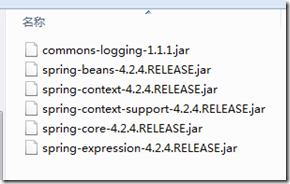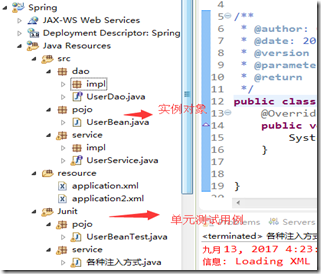Spring註入(IOC):
阿新 • • 發佈:2017-09-16
str out int -i 一個個 mls cst inter isp
簡單來說就是減少層與層之間的耦合關系,本來在service調用dao要new,有了這個就可以通過註入的方式,相當與把所有的new操作都變成了在配置文件中配置,有改動時直接改配置就行了不用一個個java文件去改。
1.搭建web項目,導入spring核心包。copy到web目錄lib即可。

項目的構成:

1.首先是創建一個bean。省略setter、getter
public class UserBean{ private String userName; private int age; private Date birthday; private double salary; }
建立spring的配置文件application.xml
<?xml version="1.0" encoding="UTF-8"?> <beans xmlns="http://www.springframework.org/schema/beans" xmlns:xsi="http://www.w3.org/2001/XMLSchema-instance" xmlns:p="http://www.springframework.org/schema/p" xmlns:context="http://www.springframework.org/schema/context" xmlns:aop="http://www.springframework.org/schema/aop" xmlns:tx="http://www.springframework.org/schema/tx" xsi:schemaLocation="http://www.springframework.org/schema/beans http://www.springframework.org/schema/beans/spring-beans.xsd http://www.springframework.org/schema/context http://www.springframework.org/schema/context/spring-context.xsd http://www.springframework.org/schema/aop http://www.springframework.org/schema/aop/spring-aop.xsd http://www.springframework.org/schema/tx http://www.springframework.org/schema/tx/spring-tx.xsd"> <import resource="application2.xml"/> <bean id="UserBean" class="pojo.UserBean" scope="singleton" lazy-init="true"> <!-- singleton – 單例模式 ,即整個應用只有一個實例 。適合於服務 bean 和Dao Bean。單例模式的對象實例在容器啟動時候就會創建。 ? Prototype – 原型模式,即每次請求都創建一個對象。適合於action bean。原型模式的對象在請求對象時候創建 lazy-init - 懶加載,默認=false,啟動就創建(不懶),true就是懶加載 --> <property name="userName" value="zs"></property> <property name="age" value="18"></property> <property name="birthday"> <bean class="java.util.Date"></bean> </property> <property name="salary" value="9000.33"></property> </bean> </beans>
單元測試,通過配置文件獲得創建的對象。兩種方式獲得。都能打印出結果。
public class UserBeanTest { @Test public void test() { //啟動spring 容器,指定配置文件。 ApplicationContext ctx=new ClassPathXmlApplicationContext("application.xml"); //通過容器獲取UserBean對象 UserBean bean=(UserBean) ctx.getBean("UserBean"); System.out.println(bean.toString()); } @Test public void testByFactory(){ //通過工廠類得到bean對象 Resource resource= new ClassPathResource("application.xml"); BeanFactory factory=new XmlBeanFactory(resource); //通過容器獲取UserBean對象 UserBean bean=(UserBean) factory.getBean("UserBean"); System.out.println(bean.toString()); } }
結果:
UserBean [userName=zs, age=18, birthday=Wed Sep 13 16:37:20 CST 2017, salary=9000.33]
2.對象的註入。
新建dao和impl
public interface UserDao { public abstract void print(); } ---------------------------------------------------------------------------------------- public class UserDaoImpl implements UserDao { @Override public void print() { System.out.println("dao打印:"); } }
新建service和impl
public interface UserService { public abstract void print(); } ------------------------------------------------------------------------------------------- public class UserServiceImpl implements UserService { //要註入它 UserDao dao; @Override public void print() { dao.print(); } public UserDao getDao() { return dao; } public void setDao(UserDao dao) { this.dao = dao; } }
建立配置文件2號
<?xml version="1.0" encoding="UTF-8"?> <beans xmlns="http://www.springframework.org/schema/beans" xmlns:xsi="http://www.w3.org/2001/XMLSchema-instance" xmlns:p="http://www.springframework.org/schema/p" xmlns:context="http://www.springframework.org/schema/context" xmlns:aop="http://www.springframework.org/schema/aop" xmlns:tx="http://www.springframework.org/schema/tx" xsi:schemaLocation="http://www.springframework.org/schema/beans http://www.springframework.org/schema/beans/spring-beans.xsd http://www.springframework.org/schema/context http://www.springframework.org/schema/context/spring-context.xsd http://www.springframework.org/schema/aop http://www.springframework.org/schema/aop/spring-aop.xsd http://www.springframework.org/schema/tx http://www.springframework.org/schema/tx/spring-tx.xsd"> <!-- set註入:對應在服務層調用dao給它setter、getter --> <bean id="dao" class="dao.impl.UserDaoImpl"></bean> <bean id="service" class="service.impl.UserServiceImpl"> <property name="dao" ref="dao"></property> </bean> <!-- 內部bean方式,也要setter、getter --> <bean id="service2" class="service.impl.UserServiceImpl"> <property name="dao"> <bean class="dao.impl.UserDaoImpl"></bean> </property> </bean> <!--P:命名空間註入屬性值 也要setter、getter,跟set註入一樣的,就是減少了property的數量。p:dao-ref="dao" 中的‘dao‘換為對應的註入對象即可--> <bean id="service3" class="service.impl.UserServiceImpl" p:dao-ref="dao"></bean> <!--自動註入(autowire) --> <bean id="service4" class="service.impl.UserServiceImpl" autowire="byName"></bean> <!--?Aotowire=byType:根據名稱屬性類型自動進行註入。 --> <bean id="service5" class="service.impl.UserServiceImpl" autowire="byType"></bean> </beans>
在原來的配置文件中加上import把兩個連接起來。
<import resource="application2.xml"/>
單元測試。
public class 各種註入方式 { @Test public void test() { //set註入 /** application.xml 要import */ ApplicationContext applicationContext=new ClassPathXmlApplicationContext("application.xml"); /** 合並的寫法 */ // ApplicationContext applicationContext=new ClassPathXmlApplicationContext(new String[]{"application.xml","application2.xml"}); UserService service= (UserService) applicationContext.getBean("service"); service.print(); } @Test public void test2() { //內部bean ApplicationContext applicationContext=new ClassPathXmlApplicationContext("application.xml"); UserService service= (UserService) applicationContext.getBean("service2"); service.print(); } @Test public void test3() { //命名空間註入 ApplicationContext applicationContext=new ClassPathXmlApplicationContext("application.xml"); UserService service= (UserService) applicationContext.getBean("service3"); service.print(); } @Test public void test4() { //按照名字自動註入 ApplicationContext applicationContext=new ClassPathXmlApplicationContext("application.xml"); UserService service= (UserService) applicationContext.getBean("service4"); service.print(); } @Test public void test5() { //按照類型自動註入 ApplicationContext applicationContext=new ClassPathXmlApplicationContext("application.xml"); UserService service= (UserService) applicationContext.getBean("service5"); service.print(); } @Test public void test6() { //獲取bean的另一個寫法,會自動在配置文件中找對應的class類型匹配,但是配置文件裏面自能有一個對應的類,多了也錯 ApplicationContext applicationContext=new ClassPathXmlApplicationContext("application.xml"); UserService service= (UserService) applicationContext.getBean(UserService.class); service.print(); } }
test6這種獲取bean的方式要只有一個才可以,很多個bean都是一樣的,僅僅是id不同會報錯的。
3.註解方式。
Spring註入(IOC):
